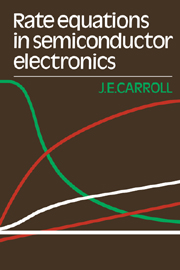Book contents
- Frontmatter
- Contents
- Preface
- 1 Introduction to rate equations
- 2 Elementary rate equations in semiconductors
- 3 Rates of switching
- 4 Rates of change and transfer in phase space
- 5 Rate equations in quantum electronics
- 6 Rate equations in optoelectronic devices
- 7 Advanced topics in rate equations
- Appendix A Counting states
- Appendix B Notes on differences between gas and diode laser rate equations
- Notes on solutions
- References
- Index
7 - Advanced topics in rate equations
Published online by Cambridge University Press: 04 December 2009
- Frontmatter
- Contents
- Preface
- 1 Introduction to rate equations
- 2 Elementary rate equations in semiconductors
- 3 Rates of switching
- 4 Rates of change and transfer in phase space
- 5 Rate equations in quantum electronics
- 6 Rate equations in optoelectronic devices
- 7 Advanced topics in rate equations
- Appendix A Counting states
- Appendix B Notes on differences between gas and diode laser rate equations
- Notes on solutions
- References
- Index
Summary
Introduction
Further exciting developments in rate equations are possible. Some of these more advanced uses and techniques are touched on in this chapter, singling out laser devices which will find applications in communications. The statistical information that can be provided by rate equations has been one theme in this book and is developed further to demonstrate how the output of a single mode injection laser changes from a chaotic distribution to a Poisson distribution as the drive current into the laser is increased.
The injection laser normally has several modes. It is useful then to show how rate equations can handle such multimode problems. In particular this section emphasises the importance of spontaneous emission in determining mode amplitudes.
Rate equations, as interpreted here, have been concerned with rates of change of energy, momentum, quanta, charge and so on. These equations have all removed any information of the phase of quantum or electromagnetic waves. In phenomena where phase is important more detailed discussions using full quantum or electromagnetic theories are usually required. To demonstrate the importance of phase and also to demonstrate how the rate equation approach can sometimes be modified to include phase, the ‘mode locked’ laser is discussed briefly. This topic follows on naturally from the multimode rate equations because in a mode locked laser there are many optical modes at equally spaced frequency intervals but with their amplitudes locked to zero phase at one time. The resultant output from such mode locked lasers can be a train of exceptionally short pulses, down to subpicosecond durations with nanosecond repetition rates.
- Type
- Chapter
- Information
- Rate Equations in Semiconductor Electronics , pp. 128 - 158Publisher: Cambridge University PressPrint publication year: 1986



